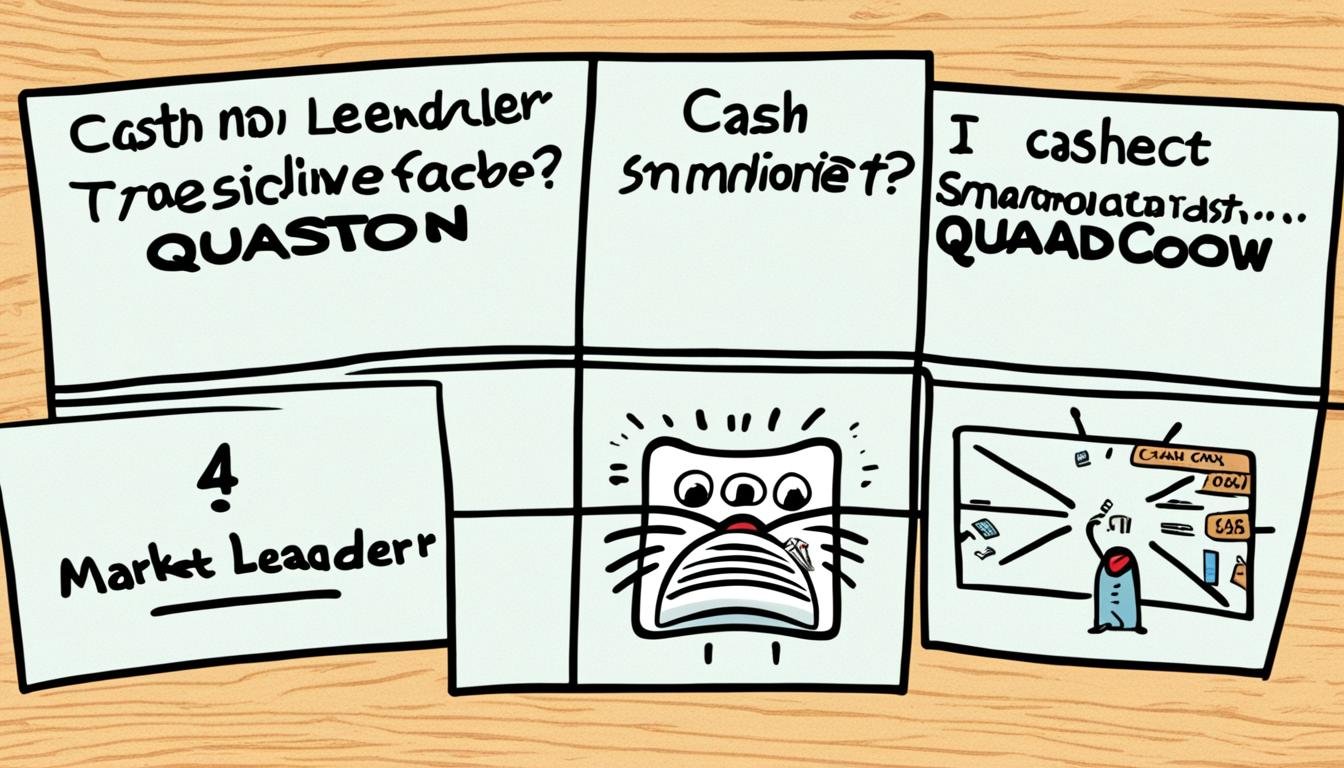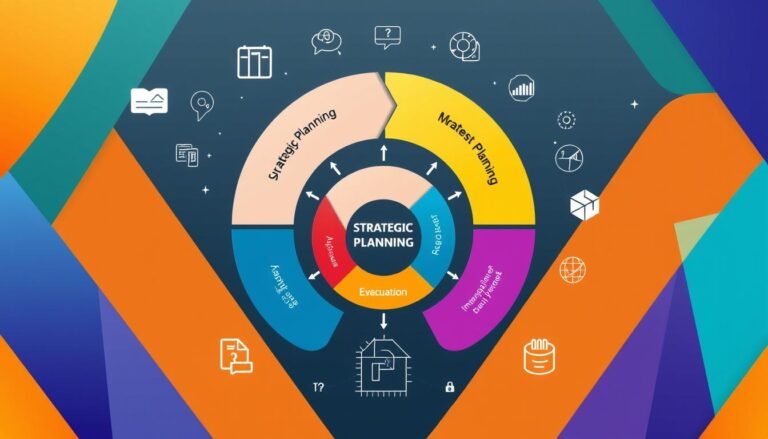Using the BCG Matrix to Analyze Tech Startups
Did you know that tech startups with high market share and growth rates are called “stars” in the BCG Matrix? These startups often make a lot of cash, helping them become leaders in the market. Knowing where your startup fits in this matrix can be crucial to success or failure.
The BCG Matrix application is key in the fast-changing tech world. It was first used by the Boston Consulting Group and made famous by Bruce Henderson in 1970. This tool helps you see your business’s potential and manage resources well. It puts your products or business units into four groups: Stars, Cash Cows, Question Marks, and Dogs.
These groups are based on market share and growth rates. The BCG Matrix is very useful for managing your startup’s portfolio and checking how well it’s doing.
Key Takeaways
- The BCG Matrix puts products into Stars, Cash Cows, Question Marks, and Dogs based on market share and growth rate.
- Startups with high growth and market share are seen as “stars,” showing they make a lot of cash and can grow more.
- Products with a big market share but slow growth are called “cash cows,” meaning they make steady money but don’t grow much.
- Startups with a small market share but fast growth are “question marks,” showing they face growth challenges but have chances to improve.
- The matrix is vital for deciding where to put resources, planning investments, and making strategic choices in tech.
Introduction to the BCG Matrix
The BCG Matrix was created by the Boston Consulting Group in the 1970s. It’s a key portfolio management framework for checking how well digital products do. It puts products into four groups – Stars, Cash Cows, Question Marks, and Dogs – each with its own strategy.
What is the BCG Matrix?
The BCG Matrix looks at products with two main factors: their market share and how fast the market is growing. This helps companies decide where to put their money, grow, or cut their losses. Having a big market share usually means making more money, so knowing this is key to making the most of your investments.
History and Development
Alan Zakon and his team at BCG first came up with the BCG Matrix. Bruce Henderson later made it even more popular. Their work started a strong strategy planning process that’s still useful today. Looking back, we see how the BCG Matrix has changed over time, becoming a flexible tool for many industries.
Core Components: Market Growth and Market Share
The BCG Matrix focuses on market growth and market share. These are crucial for spotting chances and risks in a product lineup. BCG matrix analytics use these to sort products into:
- Star: High market share in fast-growing markets, needing a lot of investment.
- Cash Cow: High market share in slow-growing markets, making steady money.
- Question Mark: Low market share in fast-growing markets, needs thought on investing.
- Dog: Low market share in slow-growing markets, might be sold.
Using a portfolio management framework like the BCG Matrix helps companies manage resources better, grow, and improve product performance. By focusing on market share, companies can adjust to market changes and make their portfolios stronger, staying ahead in the competition.
Why the BCG Matrix is Useful for Startups
The BCG Matrix sorts products into four groups: stars, cash cows, question marks, and dogs. For startups, knowing these groups is key to a good startup growth strategy. It’s a vital tool for making smart decisions on how to use limited resources.
Stars are products that grow fast and are popular in the market. They need more investment to keep their spot and grow more. This makes it easier for startups to pick where to put their resources.
Cash cows are popular but don’t grow much. They make steady money with little effort. Startups can use this money to fund new projects, helping their growth.
Question marks grow fast but aren’t yet popular. They need a lot of money to make money. Tools for making strategic decisions help figure out if investing more is worth it or if it’s time to stop.
Dogs don’t grow much and aren’t popular. They don’t make much money and need little investment. Knowing when to stop investing in them is crucial for managing resources well.
The BCG Matrix guides startups on how to grow by showing where to invest, keep, or cut. It ensures a smart way of using resources and planning for the future.
How to Assess a Startup using the BCG Matrix
The Boston Consulting Group (BCG) Matrix is a key tool for assessing startups. It looks at market share and growth rate to see a startup’s potential. This helps in making smart investment choices and deciding where to use resources best.
Identifying Market Share
Knowing a startup’s market share is crucial in startup market analysis. It shows how the startup stands against its rivals. Startups should look at their sales compared to the industry’s total sales to find their market share.
Having a high market share often means leading the market. But remember, it takes time and effort to get there. For example, Tesla became a leader through constant innovation and careful planning.
Determining Market Growth Rate
Figuring out the market growth rate is about assessing growth potential. Startups must study the market trend to see where their industry is headed. A fast-growing market means more chances for a startup to succeed.
Looking at past data, current trends, and future forecasts is key. Knowing the market growth rate helps startups understand if they need to invest a lot to compete and see big returns. Amazon, for instance, keeps investing in new areas to stay ahead.
The BCG Matrix helps startups put their products or services into four groups: Stars, Cash Cows, Question Marks, and Dogs. Each group guides strategic decisions, showing where to use resources for the best results. This helps startups aim for long-term success.
The Four Quadrants of the BCG Matrix
The BCG Matrix was created by Boston Consulting Group in the 1970s. It sorts products into four groups based on market growth and market share. Knowing these groups helps with planning and using resources well.
Understanding Stars, Cash Cows, Question Marks, and Dogs
The BCG Matrix has four parts: Stars, Cash Cows, Question Marks, and Dogs. Each one has its own strategy:
- Stars: These are products in fast-growing markets with a big share. They need a lot of investment to keep growing. For instance, the Apple Watch is a Star because it leads in the smartwatch market.
- Cash Cows: These are products with a big share in slow-growing markets. They make a lot of money, which helps fund new projects. Coca-Cola is a Cash Cow because it’s a top seller in soft drinks.
- Question Marks: These are products in fast-growing markets but don’t lead yet. Deciding what to do with them is tough because they could grow but need a lot of money. Google Glass is an example of a failed Question Mark.
- Dogs: These are products with a small share in slow-growing markets. They often don’t make much money and might be sold. Vinyl records are a Dog because they lost out to CDs and streaming.
Using the BCG Matrix helps companies check their product lineup. It gives a clear way to plan and use resources well. By knowing the different groups, companies can make smart choices based on the market and competition.
Stars: High Growth and High Market Share
“Stars” in the BCG Matrix show the top of market success. They have a high market share and grow fast. These businesses or products lead their fields and have great growth potential. Many Fortune 500 companies have shown how important it is to use the growth share matrix to find these stars.
It’s key to invest a lot to keep these businesses growing. Companies need to put a lot of resources into these stars. This helps them become cash cows in the future. For example, Apple used the BCG Matrix well. It helped the iPod go from a new hit to a reliable cash maker.
New startups that grow quickly are also stars. They need support to stay ahead and make the most of their growing markets. The BCG Matrix, created by the Boston Consulting Group, is a key tool in learning about business strategy. It helps show where to put resources and make investment choices.
- Stars are known for their strong market position and fast growth.
- Putting in strategic investments is key to keeping them ahead.
- Examples like Apple’s iPod show how well the growth share matrix works.
- New startups that grow fast are the main stars. They need strong support to become profitable over time.
By focusing on these promising areas, companies can use their resources better. This leads to steady growth and profits. As business changes, using the BCG Matrix wisely is smart. It shows how to lead in the market.
Cash Cows: High Market Share but Low Growth
Cash Cows are key in the BCG Matrix. They have a big market share in slow-growing industries. For mature startups, they are vital for steady stable revenue streams. They need little investment and help fund other areas of the business that could grow more, like Stars and Question Marks.
Take Apple’s Mac products, for instance, which made $29.36 billion in 2023. These products are perfect examples of Cash Cows. They show how mature startups can use them for financial stability. The steady money from Cash Cows lets companies put money into areas that could grow more.
Companies can keep their Cash Cows profitable with smart marketing. This keeps the money flowing in and prepares the company for new investments. So, knowing how to use Cash Cows is crucial for mature startups that want to grow and stay stable.
Question Marks: Potential for Growth with Low Market Share
Question Marks in the BCG Matrix are products in high-growth markets but with a small market share. They have a lot of potential. With smart investment, they could become Stars. But, risk assessment in startups is key because the risks are high. Wrong choices could lead to big losses.
Investment Opportunities
Investing in Question Marks can be very rewarding because of their growth potential. With the right strategies, these products could lead the market.
- Use new marketing methods to get noticed.
- Put money into making the product better to increase market share.
- Look for partnerships to help grow faster.
Risks and Considerations
The rewards are big, but so are the risks. It’s important to do a detailed risk assessment in startups before investing. Look at the market, competitors, and how customers behave. You might need to sell if the product doesn’t do well.
Question Marks in the BCG Matrix are all about balancing risks and opportunities. With careful planning, they can become big money-makers.
Dogs: Low Growth and Low Market Share
In the BCG Matrix, the Dogs quadrant shows products or business units with low growth and low market share. These products often make little money and don’t have much chance to grow. Companies with these products should think about selling them to use their resources better.
For example, Unilever sold Slim-Fast in 2014 because people’s tastes in weight loss products were changing. In 2021, Unilever also sold some Lipton tea assets because the market was changing. Despite this, Lipton still helped Unilever sell about 143 billion servings of tea each year.
Planning to exit the market helps companies focus on better products. This makes them more financially healthy and frees them from struggling products. By moving resources to more promising areas, companies can stay ahead and keep innovating.
Even though the Dogs category might seem tough, making smart moves like selling off products can turn things around. It helps companies use their resources better and improve their position in the market.
Using the BCG Matrix to Analyze Tech Startups
The BCG Matrix is a great tool for tech startups to review their products. It was created by the Boston Consulting Group. It puts products into four groups: Stars, Question Marks, Cash Cows, and Dogs, based on market share and growth.
Companies like Samsung, Tesla Motors, and Amazon have used it for strategic planning. It helps startups evaluate and plan for growth, investments, and new products.
Initial Steps for Tech Startups
First, tech startups need to list and sort their products. Look at each product’s market share and growth rate. This helps in a detailed strategic business review.
It shows where to grow and how to use resources well.
Applying the Matrix Effectively
Once products are in the four quadrants, startups can take specific steps. Stars need more investment to stay ahead. Cash Cows make good profits with little investment.
Question Marks need checking to see if they can be Stars. Dogs might need to be sold or changed. The BCG Matrix helps startups plan for growth and improve their products.
By using the BCG Matrix, startups can make smart choices. These choices help meet long-term goals and keep up with market trends.
Advantages of Using the BCG Matrix
The BCG Matrix helps tech startups plan better and use resources well. It sorts products or business units by their market position. This way, companies can make smarter choices and manage their portfolios better.
Clear Framework for Decision-Making
The BCG Matrix makes decision-making clear by sorting business units into four types: Stars, Cash Cows, Question Marks, and Dogs. This helps startups see where to focus and plan better. It makes it easier to use resources where they’re most needed.
Resource Allocation Optimization
One big plus of the BCG Matrix is better resource allocation. It shows which business units are Stars, Cash Cows, Question Marks, or Dogs. This helps startups put resources where they can grow and make more money.
This method makes sure investments go to the most promising areas. The BCG Matrix shows which units need what. It’s key for checking how well business units are doing. It also helps companies set goals that match the market.
Limitations of the BCG Matrix
The BCG Matrix is a strong tool for strategy, but it has its limits. It focuses on just two things: market share and growth rate. This can lead to missing out on key factors that affect investment choices.
Important things like market conditions, competitive actions, and economic changes are left out. These can change how profitable businesses or products are.
The BCG Matrix might not see how different business units work together. For example, a “Dog” might help a “Star” or “Cash Cow” perform better. But, these connections are often ignored, leading to poor investment choices.
It also assumes that having a big market share means being profitable. But this isn’t always true. Some companies with small shares can be very profitable because they offer something special.
This means looking only at market share can be wrong. It might not show the whole picture of profitability.
The BCG Matrix doesn’t tell how getting a big market share costs. Things like marketing and product development take a lot of money. It doesn’t give clear advice on managing these costs.
Also, the BCG Matrix might not work well for new companies or markets. They often don’t have enough data to rely on. So, it’s best to use it with other tools for better strategy insights.
BCG Matrix vs. Ansoff Growth Matrix
The BCG Matrix and the Ansoff Growth Matrix are key tools for tech startups. They help guide company strategy in different ways. Each tool is useful for different business goals.
Key Differences
The BCG Matrix sorts products into four groups: Stars, Question Marks, Cash Cows, and Dogs. It looks at market growth and market share. This helps in deciding how to use resources.
Stars get a lot of investment because they’re high risk but have big potential. Cash Cows make steady money with little risk.
The Ansoff Growth Matrix has four strategies: Market Penetration, Market Development, Product Development, and Diversification. It looks at how to grow with current products and markets. Diversification, for example, means entering new markets and needs a lot of research and development.
When to Use Each Matrix
Tech startups use the BCG Matrix to manage their products. For instance, a high-risk product like the Apple iPhone needs a lot of investment. On the other hand, a successful product like Microsoft Windows can make a lot of money with little investment.
The Ansoff Growth Matrix is good for planning to grow or enter new markets. Companies can use Market Penetration to sell more of what they already have. Or, they can diversify like Google did, moving into new tech areas.
Using both matrices together helps companies make a strong strategy. Stars might use market strategies to grow. Cash Cows could try new products or markets to keep growing.
Real-World Examples: BCG Matrix in Action
The BCG Matrix is a powerful tool for startups looking to improve their product lines. It helps by offering insights into strategic development. Let’s look at a real-world example to see how the matrix works.
Case Study of a Successful Tech Startup
Coca-Cola is a great example of the BCG Matrix in action. This global brand is in over 200 countries and uses the BCG Matrix to sort its products. Products like Coca-Cola Classic are Cash Cows, bringing in steady money. On the other hand, Coke Life was a Question Mark, showing promise but not doing well in the market. It was eventually pulled from shelves in 2018, making it a Dog.
Samsung also uses the BCG Matrix well in the consumer electronics market. It has 60% of the sales, keeping products like the Galaxy series as Cash Cows. New tech products start as Question Marks but can become Stars with the right investment.
Lessons Learned and Best Practices
From these examples, we learn a lot:
- Continuous Re-evaluation: Keep checking how products are doing in the BCG Matrix. This helps move them to the right quadrant as things change.
- Diversification Strategies: Having a mix of Cash Cows, Stars, Question Marks, and Dogs helps reduce risks and increase potential gains.
- Efficient Resource Allocation: Put resources into Star and Question Mark products. This helps with growth and sets up future wins.
Using these insights, businesses can make the most of the BCG Matrix. This leads to better startup strategies and long-term success.
Conclusion
The Boston Consulting Group’s BCG Matrix is a key tool for strategic planning recap. It’s perfect for tech startups looking to plan their startup trajectory planning. This matrix helps startups see which areas to invest in, which to grow, and which to stop.
Companies like Samsung and Tesla Motors use the BCG Matrix to find new growth areas. Apple and McDonald’s balance their products to stay profitable. These smart moves help them grow now and in the future.
The BCG Matrix has its limits but is still a great tool for BCG Matrix summary. It helps businesses use their resources well and lower risks. By sorting products into different groups, the matrix helps make decisions that match long-term goals. This leads to smart, data-based choices for tech entrepreneurs wanting to succeed and grow.
Source Links
- Use the BCG Matrix When Assessing Startups – FasterCapital
- How to use the BCG Matrix | Smart Insights Digital Marketing
- How to Use a BCG Matrix
- BCG Matrix for Maximizing Your Digital Product Success | Aguayo’s Blog
- The BCG Matrix: How to Strategically Improve Your Product Portfolio
- BCG Matrix: Examples and How to Use It | SafetyCulture
- How BCG Matrix Can Help Your Business – Fashinnovation
- BCG Matrix – Learn How To Use With Examples
- How to use the 2×2-Matrices and the BCG-Matrix in Case Interviews
- BCG Matrix: Evaluating Your Business Portfolio | startuptools.ai
- What is the BCG Matrix? Explaining its Components and Quadrants
- BCG Matrix – Definition, How to Use, Formula & Example
- BCG Matrix, Boston Matrix, BCG Matrix Template – GroupMap
- What Is the Growth Share Matrix?
- Understanding the BCG Growth Share Matrix and How to Use It
- Understanding the BCG Growth Share Matrix and How to Use It
- BCG Matrix
- How to Use the BCG Growth Share Matrix | ClickUp
- Market Share: Maximizing Success with BCG’s Approach – FasterCapital
- BCG Matrix: The Growth-Share Matrix In A Nutshell – FourWeekMBA
- 14 BCG Matrix Examples to Unlock Growth Opportunities | Creately
- BCG Matrix explained including an example
- BCG Matrix: Definition + 5 Examples of use in 2024!
- BCG Growth–Share Matrix
- The BCG Matrix and the danger of simple frameworks
- What are the advantages and disadvantages of using the BCG matrix to analyze your product portfolio?
- BCG Matrix Vs. Ansoff Matrix – FourWeekMBA
- How do you align BCG matrix with other strategic frameworks?
- Best 10 BCG Matrix Examples for Students
- Is the BCG Matrix Analysis still relevant in the Digital Age?
- The BCG Matrix in Project Management







